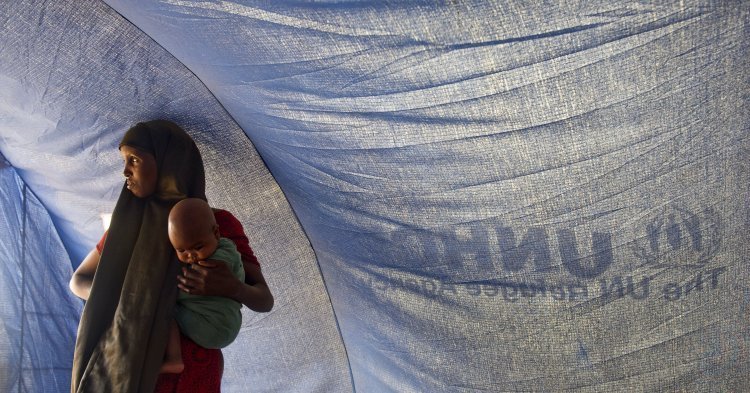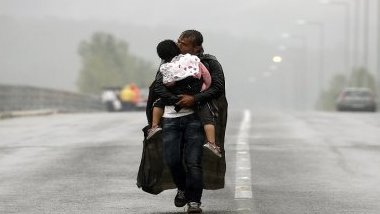This unprecedented text, whose negotiations ended in July 2018, seeks to promote the respect and safety that the 258 million international migrants deserve. The agreement is explicitly non-binding for the countries that sign it, which hasn’t stopped it from being boldly criticised by some governments well-known for their isolationist and repressive policies towards immigrants. Some countries have already announced that they would not ratify the Compact, such as Italy, Austria, Australia, the United States, Israel, Hungary and Poland. France and Germany however have committed to ratifying it.
What type of migration is the compact affecting?
The ‘migrant’ is a figure as equally exploited and politicised as it is unknown, ignored, mistrusted, repressed and abused (or, sometimes, helped and supported). It has the strange characteristic of being undefinable and elusive, especially to those who seek to drive them away. International law has been trying for a long time to integrate this status in its legal framework without actually succeeding in giving a clear, precise universal definition.
Several definitions exist, such as those that define a migrant as “any person who lives temporarily or permanently in a country where he or she was not born, and has acquired some significant social ties to this country” for UNESCO, “a person who is to be engaged, is engaged or has been engaged in a remunerated activity in a State of which he or she is not a national” for the OHCHR, “any person who is moving or has moved across an international border or within a State away from his/her habitual place of residence, regardless of (1) the person’s legal status; (2) whether the movement is voluntary or involuntary; (3) what the causes for the movement are; or (4) what the length of the stay is” according to IOM, or indeed “people moving for reasons not included in the legal definition of a refugee” for the UNHCR. This time, the compact intends to address “migration in all its dimensions.” (Preamble, 4.).
In other words, this compact concerns the 258 million individuals who have left their countries of origin by choice or by force, whether they are migrant workers, refugees, students, asylum seekers, slaves or ‘undocumented’, all the while reaffirming the status of ‘refugee’ as enshrined in the 1951 Geneva Convention, which the compact intends to preserve (Preamble, 4.) and which in any case will be the subject of a second compact currently being planned by the UN.
For example, it affects 5 million Indian, Bangladeshi and Pakistani workers who work in the United Arab Emirates, 10 million Philippine women working across the world as housemaids, waitresses or prostitutes, tens of thousands of migrants imprisoned in Libya, 1.3 million foreign workers in Singapore on building sites and in hotels, 3.6 million Syrian refugees in exile in Turkey because of the war that has resulted in half a million deaths, the 230,000 Chinese working in Africa, tens of thousands of Nigerian sex slaves exploited across Europe, 2 million Venezuelans who have left their country since 2015 because of shortages and the regime’s repression, the million exiled Congolese and Sudanese refugees living in Uganda, the 60,000-100,000 North Koreans working abroad for their regime, the 5 million students studying abroad. It also concerns the 120,000 asylum seekers in France.
What’s more, this text takes into account the worrying issue of environmental migration under two distinct dimensions, mentioning on one hand “migrants compelled to leave their countries of origin owing to slow-onset natural disasters, the adverse effects of climate change, and environmental degradation, such as desertification, land degradation, drought and sea level rise, including by devising planned relocation and visa options, in cases where adaptation in or return to their country of origin is not possible” (Obj.5, 21.h) and on the other hand “migrants compelled to leave their countries of origin owing to sudden-onset natural disasters and other precarious situations, such as by providing humanitarian visas, private sponsorships, access to education for children, and temporary work permits, while adaptation in or return to their country of origin is not possible” (Obj.5, 21.g). Tomorrow, it could affect 40 million people dependent on Lake Chad that is currently in the final stage of drying up, or indeed the 143 million Bangladeshis threatened by the rising seas in the Bay of Bengal.
Why this compact?
With the existence of the 1951 Geneva Convention on refugees, the 1990 Convention on the protection of migrant worker rights and the members of their family, or the 1949 ILO Convention on migrant workers, it’s easy to wonder why this compact could be needed. It essentially encouraged the signatory states to treat migrants in a dignified way, to respect their fundamental rights and to protect them from dangers they could be exposed to because of the different sorts of vulnerabilities inherent to migration. Contrary to what certain politicians think, it’s not an ‘extra’ legal right afforded to migrants, since the compact “reaffirms the sovereign right of States to determine their national migration policy and their prerogative to govern migration within their jurisdiction”. (Unity of Purpose, 15.) Neither is it a call for emigration, since one of the compact’s objectives is to “minimize the adverse drivers and structural factors that compel people to leave their country of origin” (Obj. 2).
This compact encourages the signatory States (as well as civil societies that they administer) to consider migrants, whatever their status, with respect, dignity, compassion and humanity, especially putting emphasis on vulnerabilities linked to gender and childhood. One could question the point of having long discussions about a text that will have no binding legal value, but it is its symbolic and political nature, however, that has value. Because co-signing this text would allow recognition of the importance of embarking on protective and integrative measures for migrants, whatever their reasons for being in the country. The emphasis has never been on the simple but important idea of ensuring the safety of individuals, their mental and physical health, rather than their rights or their status, that the States will always have the freedom to define themselves. This compact is not revolutionising the idea that every human being has the right to a dignified life, it only affirms that departure, transit and host States have to consider migrants in their countries for what they are: legitimate human beings, and to protect them and treat them as such.
Additionally, the compact claims to be innovative because of its accounting for women’s excessive vulnerability; they are systematically victims of persecution, extreme violence or denial of freedom. It is also a trailblazer because it takes into account environmental migration which we cannot allow ourselves to ignore any longer; it is a crucial issue of the 21st century, because there could potentially be 1 billion ‘climate refugees’ by 2050. It highlights the importance of coordinating to ensure the safety of migrants where other countries can fail, as is the case in the cemetery that the Mediterranean Sea and the Sahel have become (Obj. 8).
Furthermore, it promotes cooperation in the fight against modern slavery (Obj. 6), which has around 40 million victims worldwide, and human trafficking (Obj. 10), the global revenue of which is estimated at 150 billion dollars, sharing methods for individuals’ legal identification (Obj. 4), especially for 4 million stateless people, portability (not just access) of social security benefits (Obj. 22) and qualifications (Obj. 18), enhancing availability and flexibility of pathways for regular, safe and legal migration (Obj. 5), humanitarian visas as recently suggested by MEPs (Obj. 5, g.), family reunification and coordinating efforts to find missing migrants (Obj. 8), implementation of inclusive integration measures in transit and host countries (Obj. 15-16), regulation of money transfers that totalled 466 billion dollars in 2017 (Obj. 20), or holding public influencers (such as the media and political spokespersons) responsible when they talk about the subject of migration (Obj. 17).
A collective aim: for victims and for peace
On reading the first lines of the compact, it is quickly evident that all precautions have been taken to maximise the chances that UN member states will sign it. As it happens, it still underestimated the strength of the migration sceptics’ mistrust, especially in countries governed by those little inclined to afford any consideration to migrants, whichever type they may be.
The UN’s migration compact’s goal is to give a common framework of management to a phenomenon already very widespread on earth. It’s not widespread in brute number, because it only affects a tiny minority: 3.4% of the world population. Neither is it to be perceived as aggressive or offensive, it is simply a global phenomenon, systemic and systematic, that we can’t overlook. No person is foreign on this planet, and we are all descended from migrants. This is exactly what the sceptics force themselves to deny, in the desperate hope of ‘preserving’ their communities they claim are ideal, sometimes violently, by words or actions. If xenophobia and racism are the evils known and spread, it’s always the very popular idea of believing that foreigners migrating to one’s own land are a threat, against whom we should absolutely protect ourselves to avoid the collapse of civilisation. It is denying the ancient (and today, indisputable) existence of a global network of exchanging ideas, practices, initiatives, hopes, passions, goods, services, but also living spaces that represent migration, whether it is for tourism, studying, political, economic or forced.
This migration can happen between two neighbouring towns, regions of the same country or two villages separated by an ocean. Migration has existed as long as the human species could walk, it was even a strength in the harshest periods of our history. For what it’s worth, the compact is not an ode to cosmopolitanism, doing away with borders or homogenisation of culture, as many wrongly fear. Instead, it simply encourages its signatories to recognise the phenomenon’s existence, and the dangers it entails which numerous people today are victims of, and which countries and societies must act against, together.
Not signing the pact, further than displaying mistrust of multilateralism, is also an unabashed affront to the inalienable fundamental rights defined by the Universal Declaration of Human Rights (which recently turned 70) and carried by all human beings whoever or wherever they are. Does this line of thinking mean that certain human beings, because they are foreigners, do not deserve to be protected against abuse, crime, persecution or even the environmental damage characteristic of the Anthropocene that they are likely to suffer? Would this criticism support the idea that to preserve the presupposed ‘purity’ of one’s own living space, (but also prosperity thanks to numerous exchanges with the outside world), foreigners living in this space are not legitimate enough to benefit from assistance when they are in danger? Yes, probably, and this idea should be resisted, because it can only lead to hatred towards the ‘Other’, the unknown or strangers whether they come from the other side of the globe or the next valley. This dark idea, if it were to persist and become a norm, could only be described as the ‘mother’ of inwardness, isolation or even armed conflict.
More than ever, humanity must define itself as a family sharing a common planet. Each of our lives depend on the balance and interdependence of a fragile ecosystem gravely threatened by inequalities and climate change. The global compact for migration is an appeal for tolerance, fraternity and mutual respect between peoples, whatever their hopes or differences, without attacking nations’ sovereign independence. It expresses hope that individuals who migrate internationally (whether by choice or not) will no longer be victims of unfair prejudice because of their situation. This compact comes from a strong, collective will to evolve together to preserve not only what we are, but above all else, the most valuable thing: peace.







Follow the comments: |
|
